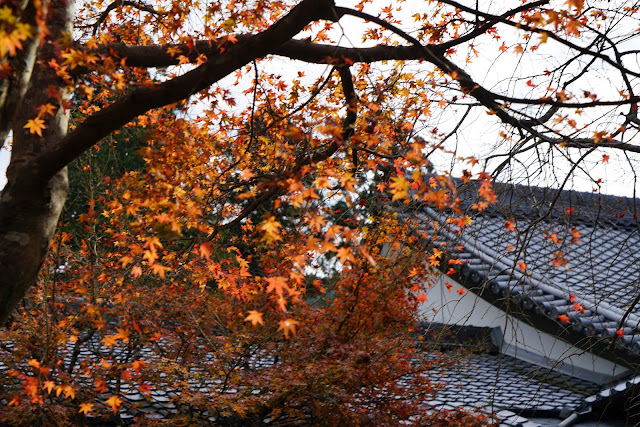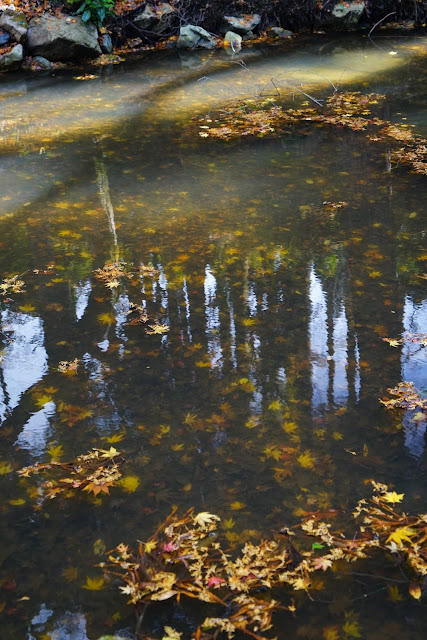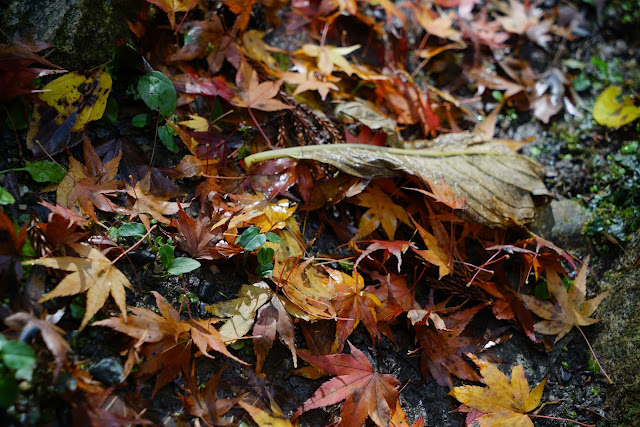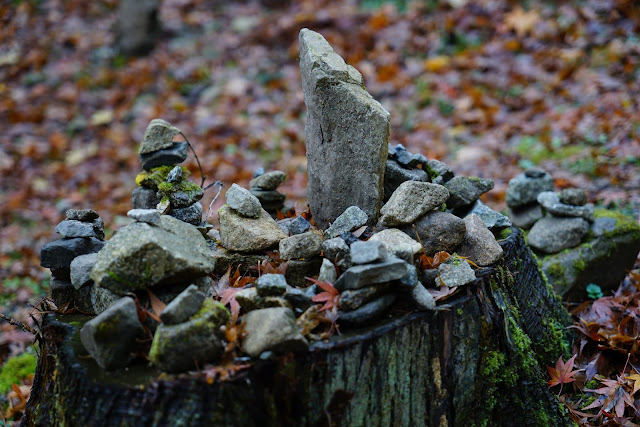According to the Wikipedia:
(1) Religion in Japan is dominated by Buddhism and Shintoism (the ethnic religion of the Japanese people). Yet, according to surveys done in 2006 and 2008, less than 40% of the Japanese identify themselves with any organized religion. Only around 35% claim to be Buddhists, 3% to 4% Shinto and related sects and less than 1% to 2.3% Christians.
(2) Most Japanese (50% to 80%) who worship ancestors and gods (神 kami, shin or jin) or take part in Shinto rituals and worship at Shinto shrines or private altars would not identify themselves as "Shintoists" ( kami-no-michi) (神道) because to them , the term "religion" (宗教 shūkyō) itself is understood as meaning only "organised religions" with specific doctrines and formal membership but they are not such members. Scholars like Isomae Jun'ichi and Jason Ānanda Josephson argue that the Japanese term and concept of "religion" (shūkyō) is only an invention of the 19th century.
(3) Like the Chinese, who even now worship all kinds of gods, whether it be Buddha (覺者), the bodhisattvas ( 菩薩), the koonyins or guanyin (觀音), local earth gods (土地), hearth god (灶君), tree gods (樹神) hill gods (山神) and goddesses, the Taoist Laotzu (老子) a mythical figure credited to be author of the Dao Te Qing (道德經) , the Jade King (玉皇上帝 formally玉皇大天尊玄穹高上帝,abbreviated into 玉皇、玉帝,popularly 天公 ) or even mythical figures culled from novels like Nezha (哪吒) and Monkey king (猴王) plus their own ancestors and also like the Hindus who worship all kinds of gods and goddesses, before the Meiji period (明冶) in the 19th century, the Japanese worshipped all kinds of local deities which they mixed up indifferently with Buddhist bodhisattvas in a kind of peculiarly Japanese syncretic "religion" called Shinbutsu-shūgō (神仏習合 ) or Shinbutsu-konkō (神仏混淆 ), the only form of organized religion in Japan. Only in 1868 did the Japanese government pass laws to separate the native kami worhsip from Buddhism, which first spread from China to Japan in the 6th century, in the Asuka period (jindai) (飛鳥時代)(CE 592-645).
So I thought I might look some of them up whilst photographing the maple leaves for which I originally came. My first visit was to Sanzen-in & Jakko-in Temples, Ohara, Kyoto (京都大原三千院與寂光院).

But first, we got to take a bus at the railway terminal

We passed through some beautiful color-filled hills

and from time to time, some public buildings on the river banks

The hills and valleys were thick with vegetation

the rivers are always clean and the river banks meticulously cared for

We passed through some paddy and vegetable fields

Everything is planted in neat rows

Once we alighted from the bus, we found this tea house

with a water mill in front surrounded by Bonsai's

There was a poem on the wall


The Japanese like to place aproned stones at the roadside, sometimes with flowers and sometimes not

The path up is called the Path of the "Girls of Ohara" (Oharame) (大原女). On the 12th of May each year, as part of the Aoi festival (matsuri)(Hollyhock Festival) (May 1st to 15th May), the proud and strong girls and old women of Ohara all put on their colorful traditional costumes dating from the Muromachi era (室町時代) (1336 to 1573) and walk in a 2-km procession either on foot or on horseback from this mountain village starting with the Shorin-in (temple) ((勝林院), passing through Hosen-in(保泉院) to final destination the Sanzen-in temple (三千院). The Ohara women are strong and sturdy and used to carry their loads of firewoods and other stuffs on their head.

A glimpse of an Ohara butterfly my camera caught on my way up the Sansen-in.

A nice restaurant on the way to the temple

Another restaurants, all decked out with flowers

All the buildings are in the traditional style built with good quality timber with tiled roofs

another high class restaurant with its own courtyard

The area has plentiful rainfall. So there are flowering plants everywhere

All the walls are thick with creepers

Moss grows everywhere, even on the surface of plastic sheets

Japanese lady tourists sampling the pickles

pickled cucumbers

Other stores are selling local biscuits, candies and other snacks.

a tree branch turned into a primitive Oharame, with a bundle of firewood on her head

The delicate Japanese maple leaves are changing color everywhere

Some are already fallen

Whilst the maples are turning yellow and orange, others stay green.

All kinds of berries have ripened

I don't know what they are called. But they seem everywhere.

I suppose that they are grown purely for their fiery colors

The maple leaves come in all kinds of colors

Even the leaves of some of the creepers are turning yellow

The path up is built alongside a stream

Finally, getting close to the path to the temple

the pebble path is strewn with restaurants
They all got little show booths in front of them
This one sells a kind of dried vegetable and biscuits and cakes.

This young boy in traditional costume sells pickles

But others sell both fresh and pickled turnips

a small memorial to a donor?

A general introduction to the district

A map of the Sanzen-in Temple

The main entrance to the Temple

Overhanging maple branches above the garden wall

I was lucky:: just a few thin clouds in the sky

Fallen maple leaves on the skirting apron tiles

Maple leaves about to fall
grass has grown around this bucket

There's a well manicured garden within the temple grounds: the Shuheki-en Garden (聚碧院)

Even the lamps are covered with moss

Another moss covered rock lamp

with a pond beloved by the Japanese

The leaves of some maple trees are still green

Reflections of the temple and the trees on the surface of the pond

The garden has a variety of trees

The eaves of some of the dozens of the buildings in the Temple, all surrounded by trees.

The garden is carpeted with lawns of smooth grass blades

a statue of one of the monks

Two ginko trees with its yellowing leaves

3 Amitabha Buddha (阿彌陀佛) statues in gold, considered national treasures all.

I love the reflections of the trees on the pond

with its rippling surface

dotted here and there with fallen leaves

Looks really like an impressionist painting by Monet

I like the reflection of the moss-covered roundish boulder

The boulder from a different angle

I nearly missed this pond because it's completely hidden behind a building

Fallen leaves on the pond

The leaves came down at different times

I could look at them forever

They look so different when one has taken just another step

Some leaves fall on the edge of the pool

others converge upon one end of the pool

The reflections of the trees look so odd, when everything all seems turned upside down

From time to time, the sun penetrated through the thicket of the leaves above

I like it when there's a little breeze which creates tiny ripples, suddenly turning every shape into stirring shimmers in fractions of a second

The Japanese really like to pile one stone on top of another to create human figures

Is this the head of a man or that of an owl?

The blue sky has fallen into the water

and some leaves have fallen upon others

they create different patterns on different host leaves

or host tree stumps

Some leaves are still soaked with night rain

a newly fallen maple leaf among older fallen pine needles which have turned brown and black

they conduct stream water into buckets with hollowed out bamboo poles
But many of them just barely manage to stay connected above ground

This is the Konjiki Fudo-do (金色不動堂) housing the Konjiki Fudo Myoo ( 金色不動明王), built in 1989. In summer, the garden in front of it would be filled with blooming hydrangea.
maple red against ginko yellow
There's a special spot for
chrysanthemum from Mount Tientai (天台山). Tientai has a special meaning here
because that's where the Tientai sect of Chinese Buddhism originated, a
Buddhist sect indigenous to China and created by the third head of the
sect Zhiyi 智顗 (智者大師), based upon the teachings of the great master of
Mayayana Buddhism (大乘佛教) Nagajuna (龍樹菩薩), the creator of the
Madhyamaka (中觀論). Zhiyi taught, based on the Sad-dharma Puṇḍárīka
Sutra《妙法蓮華經》(法華經) that to advance in Buddhism, one must stick
to the rules, endure humiliation, hard work ceaselessly to improve
(持戒、忍辱、精進) by learning and putting into Zen practice these 3 treasures
of the samadhi (禪定) (法華三昧) and that in trying to achieve that, one can rely on either one of the three methods: viz.gradualism (漸次止觀) non-regularism (不定止觀)
and complete samadhi(圓頓止觀 ) representing the views of three different
sects or doctrines, viz. and even the methods of Tibetan buddhism (藏密)
because they are just different approaches to achieving the ultimate aim
of non-attachment to anything, including our attachment to what we
regard as our "self".viz.
(1) sunyata( 空論) which believes that one must realize that everything which happens, happens because of co-dependent origination (因緣起) each causing and dependent on the existence of other existing beings and hence that nothing can truly "be" itself all alone ; that the past, the present and the future are nothing which has true existence and can't be grasped by our body, only by our mind and that therefore nothing can truly exist by itself and sooner or later, everything will disappear and revert to its original non-being and hence that what we regard as our "self" is little more than a provisional coming together of various co-dependent causes of beings (existences) and has no real existence or doesn't truly exist and thus we need not get too attached to that.
(2) non- realism (假論) which teaches that if we observe what we regard as the "external world", we would realize that although everything does not truly exist, we should nonetheless not forget that the doctrine of co-dependent origination is/exists and is in a sense "true/real" and hence that we need to follow the way things happen as they happen but not get attached to any of them and thus arrive at the conclusion that what we regard as our "self" does not truly exist and that we should not get attached to such an "non-permanent" or provisional self" and also not get attached to nor be influenced by our view of all external things and happenings
(3) Madyakama (中觀論) which teaches that the nature and appearance of things are just two ways of looking at exactly the same thing (性相不二,色空不異) and hence we should neither ignore them nor get attached to them(不取不廢). If so, then we'd arrive the ultimate and complete truth without any obstacles (圓融無礙)。If we realize that the illusion, emptiness is all one, then we'd not get attached to what we regard as our "self" (破俱生我執) and transcend both the doctrine of sunyata and non-realism (空有雙超) and not get attached to a so-called "enlightened self"(光明之我). The madhyamaka teaches that externally we should not get attached to any one of the so-called "6 forms of dirt" (不住六塵) viz. sight, sound, taste, smell, touch and the valuation of them as good, bad etc for our so-called "self" and internally, not even whether we should insist upon the differences between realism and non-realism (內不住空有之中道境界。) and hence arrive at what the Buddha taught in the Heart Sutra (心經) viz. everything does not exist, nor does it not exist (諸法非有非無), they do not get born, nor are they different (不生不異) and that is the complete truth about everything (圓融一切法) and though we don't get attached to them, neither do we ignore them (雖不著而同時不捨) ,though we don't ignore them, neither do we get attached to them (雖不捨而同時不著).

This is the entrance to the Pagoda for copying Buddhist Texts (寫經塔). On one side is written the motto (Three thousand in One thought)(一念三千) which gives the temple its name and which aptly summarizes the Tientai sect's belief that everything is contained in just one thought: the belief that if we think deeply enough about anything and penetrate into its deepest level, to its ultimate "reality/non-reality", we would understand all that we need to understand about the entire universe and how it functions because everything which exists, which existed and which may exist are interconnected and co-dependent on each other such that if we understand the essence and nature one thing, one phenomenon, one matter, one event thoroughly and completely, we will have understood all thngs, all phenomena, all matters, all events because they are all related to one another as cause and effect as each exists as the other's appearance and/or reality, dependent on what perspective we are taking (and that there is no single absolutely right/ wrong ,correct/ or incorrect perspective) because there really is/exists only one unbroken, undivided "reality", something which in the final analysis, can NOT really be divided and differentiated and that even if out of practical necessity, we were to do so, we must realize that that is merely a method of practical "convenience".and not as it "ultimately" or truly" is". I realize with a shock of surprise that maybe, something led me there, thousands of miles away, to remind me once again of that Buddhist "truth" !
(1) sunyata( 空論) which believes that one must realize that everything which happens, happens because of co-dependent origination (因緣起) each causing and dependent on the existence of other existing beings and hence that nothing can truly "be" itself all alone ; that the past, the present and the future are nothing which has true existence and can't be grasped by our body, only by our mind and that therefore nothing can truly exist by itself and sooner or later, everything will disappear and revert to its original non-being and hence that what we regard as our "self" is little more than a provisional coming together of various co-dependent causes of beings (existences) and has no real existence or doesn't truly exist and thus we need not get too attached to that.
(2) non- realism (假論) which teaches that if we observe what we regard as the "external world", we would realize that although everything does not truly exist, we should nonetheless not forget that the doctrine of co-dependent origination is/exists and is in a sense "true/real" and hence that we need to follow the way things happen as they happen but not get attached to any of them and thus arrive at the conclusion that what we regard as our "self" does not truly exist and that we should not get attached to such an "non-permanent" or provisional self" and also not get attached to nor be influenced by our view of all external things and happenings
(3) Madyakama (中觀論) which teaches that the nature and appearance of things are just two ways of looking at exactly the same thing (性相不二,色空不異) and hence we should neither ignore them nor get attached to them(不取不廢). If so, then we'd arrive the ultimate and complete truth without any obstacles (圓融無礙)。If we realize that the illusion, emptiness is all one, then we'd not get attached to what we regard as our "self" (破俱生我執) and transcend both the doctrine of sunyata and non-realism (空有雙超) and not get attached to a so-called "enlightened self"(光明之我). The madhyamaka teaches that externally we should not get attached to any one of the so-called "6 forms of dirt" (不住六塵) viz. sight, sound, taste, smell, touch and the valuation of them as good, bad etc for our so-called "self" and internally, not even whether we should insist upon the differences between realism and non-realism (內不住空有之中道境界。) and hence arrive at what the Buddha taught in the Heart Sutra (心經) viz. everything does not exist, nor does it not exist (諸法非有非無), they do not get born, nor are they different (不生不異) and that is the complete truth about everything (圓融一切法) and though we don't get attached to them, neither do we ignore them (雖不著而同時不捨) ,though we don't ignore them, neither do we get attached to them (雖不捨而同時不著).

This is the entrance to the Pagoda for copying Buddhist Texts (寫經塔). On one side is written the motto (Three thousand in One thought)(一念三千) which gives the temple its name and which aptly summarizes the Tientai sect's belief that everything is contained in just one thought: the belief that if we think deeply enough about anything and penetrate into its deepest level, to its ultimate "reality/non-reality", we would understand all that we need to understand about the entire universe and how it functions because everything which exists, which existed and which may exist are interconnected and co-dependent on each other such that if we understand the essence and nature one thing, one phenomenon, one matter, one event thoroughly and completely, we will have understood all thngs, all phenomena, all matters, all events because they are all related to one another as cause and effect as each exists as the other's appearance and/or reality, dependent on what perspective we are taking (and that there is no single absolutely right/ wrong ,correct/ or incorrect perspective) because there really is/exists only one unbroken, undivided "reality", something which in the final analysis, can NOT really be divided and differentiated and that even if out of practical necessity, we were to do so, we must realize that that is merely a method of practical "convenience".and not as it "ultimately" or truly" is". I realize with a shock of surprise that maybe, something led me there, thousands of miles away, to remind me once again of that Buddhist "truth" !
Whatever the "truth" may be, I was delighted to find the crystal clear water that flowed into that tiny pool through the empty bamboo pole. Such naturalness, such purity, such vitality, such life.

There's also Kannon-do (Guanyin) Hall (觀音堂) there.

It's donated by the faithfuls so that they may pray to her for blessings

It's in the middle of Jigon Garden (慈眼之庭) or the Garden of the Merciful Eye under the blue sky.

The garden is also washed by a stream

It's littered with moist leaves.

It leads up to a slope

The root of this huge tree is completely covered up by maple leaves

a very colorful floor

so are the stone steps leading up the slope

It's amazing how may shapes and colors they can have

Some can have an entire top of a tree stump to itself

others must be content to share their bed for the time being

Still others can only have a cement bed

These must be content with a worm eaten bed

with a bridge like the one finds in Monet's painting of his own garden save for the lily pond.

The banks are all overgrown

the hollow of this moss covered tree stump is filled with various different kinds of leaves

surrounded by a thick carpet of maple leaves

Not very many leaves left to fall now

all the flat surfaces are covered by deliberate stone piles, some in the shape of people and some not.

It's obvious that the stones' placement is not random

This bust has grown some green hair

A clay doll with a fur hat

This one has only got a leaf

Of course, the Buddha has a roof over his head because it's one which dated from the Kamakura Era (鎌倉時代) (1192-1333)

This bronze Guanyin appears happy with her pipa

A clay doll with a fur hat

This one has only got a leaf

Of course, the Buddha has a roof over his head because it's one which dated from the Kamakura Era (鎌倉時代) (1192-1333)

This bronze Guanyin appears happy with her pipa








沒有留言:
張貼留言